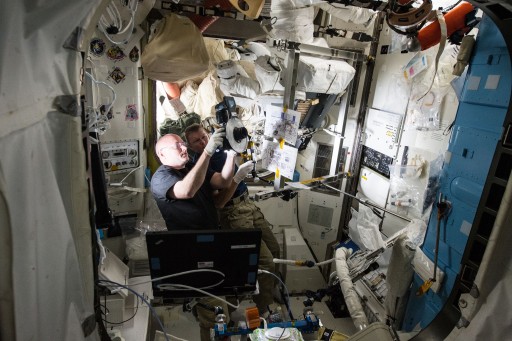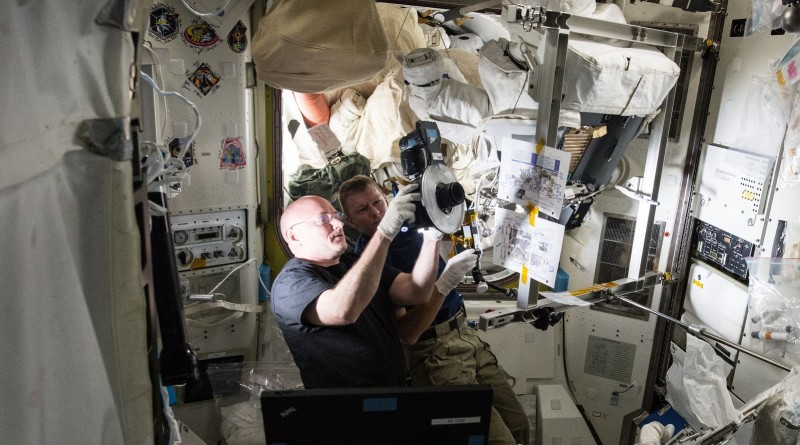ISS Operations Update – February 11, 2016

Experiments:
Ocular Health – Ocular & Cardiac Ultrasounds [OH is a human physiology study. Its full name is Prospective Observational Study of Ocular Health in ISS Crews. “The Prospective Observational Study of Ocular Health in ISS Crews (Ocular Health) protocol aims to systematically gather physiological data to characterize the Risk of Microgravity-Induced Visual Impairment/Intracranial Pressure on crewmembers assigned to a 6 month ISS increment,” the NASA experiment overview said. It is known that some (not all) astronauts in orbit experience changes in visual acuity (visual clarity) and intraocular pressure as a result of fluid shifts within the body as it is subjected to microgravity. About 20% is astronauts flying to ISS have reported these kinds of changes. Test subjects will undergo pre-flight, flight and post-flight testing of their eyes using a variety of techniques.]
Integrated Resistance and Aerobic Training Study (Sprint) – Leg Ultrasounds [This study evaluates a high-intensity, low-volume exercise protocol to minimize the loss of muscle, bone and cardiovascular function but also minimizing the time spent with daily exercise. To asses the protocol, crew members conduct regular measurements of VO2max, heart rate (HR) response to submaximal exercise and ventilatory threshold. Monthly ultrasounds of the thigh and calf are used to evaluate spaceflight-induced changes in the muscle volume. Post-flight data on muscle and bone mass is compared to pre-flight measurements and to data from control subjects that use the regular exercise protocol.]
Fine Motor Skills [Fine Motor Skills uses a tablet touchscreen application to monitor degradation in fine motor abilities over the course of an extended exposure to microgravity. A drop in fine motor skills can lead to problems when crew members are tasked with medical treatment, repairing sensitive equipment and interacting with touch-based equipment. Tests utilized by this study include multidirectional pointing, dragging, shape tracing, and object manipulation to create a knowledgebase that will allow scientists to evaluate the risk of fine motor performance decrements due to long-duration exposure to microgravity.]
Habitability Experiment Ops [Assessment of International Space Station Vehicle Habitability will see teams on the ground study video of the behavior of crew members within the habitable environment of ISS while the crew fills out questionnaires and collects video of areas of interest in order to provide an assessment of the habitability of ISS in its current state for a one-year mission. Results will be used to develop spacecraft with improved habitability properties to allow crew members to optimally utilize the onboard space.]
Vzir Experiment Operations and Tagup [Vzir (Viewfinder) uses the SKPF-U (Photo Image Coordinate Reference System) hardware, a photo image coordinate reference system using ultrasound sensors and a camera for general target views.]
Maintenance/Systems:
Nominal Inspections/Servicing Tasks (Morning Inspection, Caution & Warning Panel Check, Sozh System Maintenance) (Russian Crew)
Condensate Water Separator Assembly (CWSA) Desiccant Module Replacement
Other Activities:
Extravehicular Mobility Unit (EMU) 3003 Fan Pump Separator Remove and Replace: After successful replacement of the FPS with a spare unit, the new pump was primed and the suit readied for a standard return to service checkout. The faulty FPS failed in December during an activity to fill the Liquid Cooling and Ventilation Garment.
Cygnus OA-4 Cargo Operations
Crew Medical Officer Proficiency Training [CMO skills are reviewed and trained at various points in the mission to keep up proficiency and ensure proper responses in critical health situations on board.]
Portable Emergency Provisions Inventory
Robotics: The Special Purpose Dexterous Manipulator (SPDM) was stowed on the Mobile Base System and Canadarm2 was walked off to the Node 2 Power and Data Grappling Fixture in preparation for Cygnus unberthing & release on February 19.
Soyuz TMA-18M Kazbek Seat Fit Check

